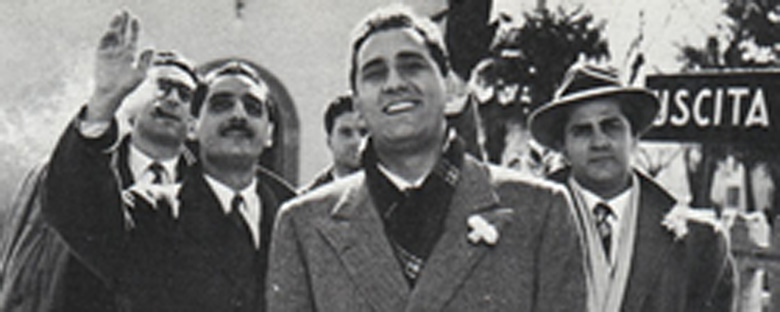Reviews
Federico Fellini
Italy, 1953
Credits
Review by Rumsey Taylor
Posted on 19 September 2004
Source The Criterion Collection DVD
Related articles
reviews: 8 1/2
reviews: The White Sheik
We are introduced to Fellini’s vitelloni at the last party of the summer. The spirit is cherubic enough, despite a ferocious rain that only manages to relocate the wine and dancing indoors. The five lackadaisical youths — the subject of the film — do not confront the immediate responsibilities of their lives, neither do they the storm at hand. Each is prey to every fleeting temptation and every temporary profit. It’s bittersweet, as these are the perennial characteristics of youth.
The occasion of this summer party is to celebrate a young debutante, Sandra. Amid frantic jazz and congratulations from everyone within earshot, Sandra faints, and her brother, Moraldo, sees to her health. (This action is photographed in one of the film’s sparing and crucial subjective viewpoints.) Later, we learn that Sandra is pregnant, and Fausto, Moraldo’s friend and fellow vitelloni, prepares to depart to Milan, unacknowledged and on a whim.
Responsibility is in the vocabulary of maturation, and the vitelloni believe it is a trait that may be assumed if not avoided entirely. I Vitelloni focuses on the brink of such responsibility, and how it affects, tempts, and threatens five males of varying interests and persuasion. The telling, unavoidable accessory to responsibility is age, which is acknowledged cleverly in Moraldo’s brand-new moustache, admired by all once he returns from a stay in Rome. Impressed and previously shorn, the remaining men try out goatees and sideburns in a gesture that exhibits a growth.
I Vitelloni is the first of Fellini’s films to include his trademark characterization: the privileged and cheerless male, speculatively one modeled after his own appearance and class and one exemplified in the roles acted by Marcello Mastroianni in La Dolce Vita and 8 1/2. I Vitelloni, however, is not replete with the embellished periods of fantasy Fellini is perhaps best renowned for. In the most fantastical scene, for measure, the vitelloni attend a town masquerade. The setting is livid and active, as if an entire roster of circus acts is performing in the same ring at the same time. The atmosphere is one of overwhelming euphoria, and the next morning the more intoxicated members emerge from a floor soiled in graffiti and exit to find an unexpected sun. It is another dawn, and the party has left without its most indulgent participants.
These traits of stubborn irresponsibility and idealism will suggestively remain intact in each male, despite the many realizations made by many of them in the film. This is not to imply a message of despair; these characters thrive for idealism, the hope that they can continue to live with sexual variety and regular entertainments. This dilemma between the desire not to mature and the infallibility of age is best summated in Nino Rota’s score. It highlights the film’s beautiful final shots and lends the final exit an air of playful hope.
We don’t do comments anymore, but you may contact us here or find us on Twitter or Facebook.



